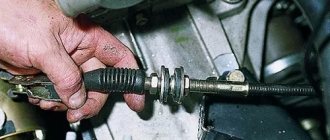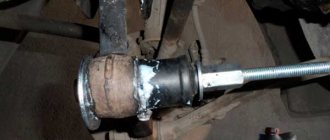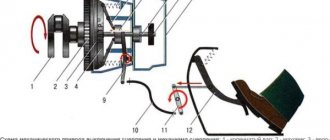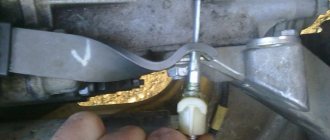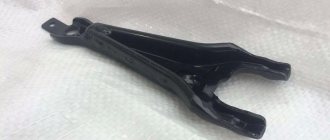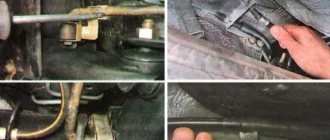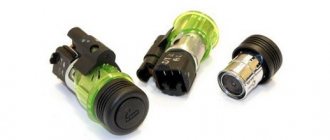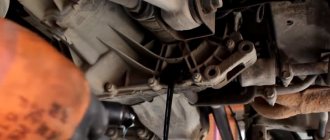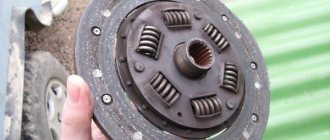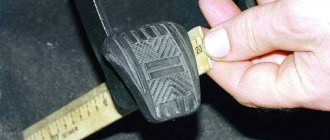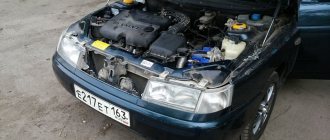2. Carefully pry up the rubber protective cover 1 with a screwdriver and remove it from the clutch release fork lever 2. Replace the torn or loose rubber protective cover.
3. Squeeze the locking tabs on the inside of the clutch housing with pliers and pry them from the outside with a screwdriver, remove the plastic bushing of the fork axle. Replace the plastic fork axle bushing if it is severely worn or if the locking tabs are damaged.
4. Lifting the fork, remove its axle from the bushing pressed into the clutch housing, and remove the fork by removing the axle, and then the lever from the holes in the clutch housing.
5. Remove the spring clip from the fork by squeezing its ends. Replace a broken or loose spring retainer.
6. Replace the clutch release fork if fork lever 1 is bent or cracked or fork legs 2 are heavily worn at the points of contact with the bearing clutch.
7. Press out the worn metal bushing, then press in the new one until it stops.
8. Before installing the fork, lubricate the metal and plastic bushings with grease.
9. Install the clutch release fork in the reverse order of removal. At the same time, make sure that the protrusion on the plastic bushing fits into the groove on the clutch housing, and its petals securely fix the bushing in the housing from falling out.
Reference manual for servicing VAZ, LADA 110 cars.
Ignition adjustment 2110. Engine compression for VAZ 2112, immobilizer for VAZ 2111. Valve cover for VAZ 2112, cylinder block gasket for VAZ video. The cost of a generator for a VAZ. replacement of fuses for VAZ 2112, design of the oil receiver for VAZ 2112. oil recommended by the factory for the box of VAZ 2112. replacement of the water pump (pump) for VAZ 2112. Replacement of valve stem seals for VAZ 2110.
Changing the clutch fork on a VAZ 2110 yourself
In order for the transmission system to operate without breakdowns, it is necessary to monitor the serviceability of all its components. One of these elements is the clutch fork. It is important to be able to perform repairs yourself. The article describes the function of the clutch fork and how to change it on a VAZ 2110.
The clutch fork (CL) is an important element of the vehicle transmission system. It is a lever with which the pressure plate is retracted, resulting in the clutch being released. The BC is sometimes called the cut-off plug.
BC is mainly part of a mechanical gearbox, less often in hydraulic drives. The design of the VS in the gearbox on a VAZ 2110 is quite simple: a metal rod on which a lever and two legs are attached.
At number 5 VS
When you press the clutch pedal (CS), thanks to the BC, the release bearing clutch moves, thus, the inner edge of the spring moves forward and the device turns off. Naturally, the correct engagement and disengagement of the clutch depends on the serviceability of the aircraft.
Aircraft replacement is required in the following cases:
- Deformation of the part is detected;
- cracks were detected on the body;
- curvature of the aircraft;
- Defects in the tabs were identified at the points of contact with the release bearing coupling;
- paws are worn out.
The photo shows a broken down aircraft.
Aircraft with a broken lever
If there are cracks on the aircraft, then this reduces the quality of the PS operation, late setting occurs, the machine may slip, and the pedal may sink when pressed. There is a need to regulate free play. Along the crack, the aircraft deviates from the release bearing. Regulation is enough for only a few days, and in case of a significant defect it is necessary to adjust after a few hours
Damage must be corrected immediately, as this can lead to rapid wear. If the aircraft breaks down completely, the pedal will fail and the vehicle will be unable to move.
You can detect a crack by visual inspection, place the car on an overpass or inspection hole, and find the fork protective boot on the bottom of the car. Having moved the boot, you need to inspect the fork for cracks; it is more convenient to use a flashlight.
Replacement process
The difficulty of replacing an aircraft with a VAZ 2110 is that it is necessary to dismantle the gearbox; the procedure for replacing the part itself is simple.
Required Tools
To carry out the aircraft replacement procedure, it is necessary to install the machine on a lifting device or inspection groove. You can lift the car with a jack and place it on supports.
From tools and materials you need to prepare:
- new aircraft;
- a set of keys;
- pliers
- screwdriver;
- flashlight;
- jack.
Having prepared all the tools, you can begin the replacement process.
New replacement part
Stages
In order to change the aircraft to a VAZ2110, you need to remove the gearbox. After dismantling the box, the following steps are performed:
- First you need to remove the clutch release bearing.
- Then, using a screwdriver, you need to pry up the protective cover of the aircraft and remove it. If it has signs of wear, abrasion, or has lost elasticity, it should be replaced.
- Next you need to remove the plastic sleeve BC. To do this, use pliers to squeeze the tabs securing the bushing and remove it.
- Next, you need to assess the condition of the bushing. If there is damage, signs of wear, or the locking tabs are broken, the part should be replaced.
- Then you need to lift the BC and remove it from the bushing located in the clutch housing (CC), and also remove the fork lever from the holes of the CL.
- Next, you need to remove the spring retainer from the aircraft. If it is damaged or has lost elasticity, it must be replaced.
- It is advisable to replace the metal sleeve pressed into the KS with a new part.
- Before installing a new aircraft, all bushings inside should be lubricated.
- Installation of the aircraft is performed in reverse order.
- When inserting a plastic bushing, you need to make sure that the petals securely hold the bushing in the joint.
Popular problems and their solutions
There are several characteristic faults that occur on the VAZ 2110. Let's try to understand the reasons for their occurrence, and also consider ways to solve the problem.
- The clutch drives. The reasons may be: The pedal has insufficient travel, the tension is too tight. To eliminate this, you need to adjust the drive;
- The driven disk is deformed. Only replacement will help here;
- The driven disc hub sometimes gets stuck. If so, try washing it and lubricating the input shaft splines. If the element or the shaft itself is worn out, then replace them;
- The friction linings are broken and the rivets are loose. The best solution is a complete replacement of the casing, which includes a spring and a disk;
- The pressure plate is warped or warped. Replace the linings, but first make sure that there are no deviations in the end runout of the disk;
- There were problems with the cable. Pull it up. If there is no result, replace with a new one.
- The friction linings on the driven disk often burn or wear out. There is only one solution - replacement;
- Oil has reached the surface. We have already described how to solve the problem above;
Features of replacing the clutch fork on a VAZ-2110, 2111, 2112
The clutch drive fork is necessary for the proper operation of the entire transmission system. This mechanism is a lever, when pressed, the following occurs: when the pedal is depressed, the clutch and release bearing move, this leads to the inner edge of the spring moving forward, and the clutch is disengaged.
When the pedal moves back, the clutch is engaged, so sometimes this spare part is called the release or engagement fork, respectively.
Typically, the clutch fork is found in mechanical gearboxes, and is occasionally included in hydraulic ones. The drive fork is a metal rod on which a lever and two legs are attached.
What are the usual malfunctions of the VAZ-2110 clutch fork that require replacement?
The clutch fork is subject to wear and tear, just like other parts. Factory defects are also possible, but due to the simplicity of the design, they are much less common.
- The clutch fork breaks. In this case, the pedal drops sharply, making it almost impossible to continue forward.
- Crack. The clutch grabs lower and lower, adjustment is almost ineffective. As the crack gets larger, the clutch pedal goes down again.
- Curvature.
- Paw wear.
- Defects of the paws at the point of contact of the liner coupling.
You need to change the fork in any case, since this part is necessary for the movement of your car. Without it, gear shifting is impossible.
The cost of spare parts is 300-500 rubles. When choosing, pay attention to the quality of the material and the thickness of the metal. Very often, a fork made of thin iron bends almost immediately.
Although the part is simple in design, it may not be so easy to replace it yourself. When contacting a car service center to replace the clutch drive fork of a VAZ-2110, you will have to pay from 1,500 to 2,500 rubles.
Replacement
If you change the fork on a classic without removing the gearbox, you can still do it, but you won’t be able to do the same on a VAZ-2110. The replacement will take 3 to 4 hours depending on experience.
- Remove the gearbox.
- Remove the pressure bearing.
- The next step is to remove the rubber cover by hooking it with a screwdriver. Pull it off the power plug. It also needs to be replaced if it becomes warped, cracked or hard.
- Use pliers to squeeze the locking tabs on one side of the crankcase. Using a screwdriver, pry up the plastic bushing of the fork axle. If there is noticeable damage or signs of wear on the cap, then it also needs to be replaced.
- We unfasten the clutch fork itself: by lifting it, you need to remove its axle from the bushing. First, the axle, then the lever, are removed from the outlets in the crankcase.
- You need to squeeze the ends of the fork spring retainer and remove it. A deformed retainer needs to be replaced.
- We replace the fork that shows signs of wear.
- It is usually recommended to replace the metal bushing as well, especially if it is noticeably worn.
- Before installing a new part, you need to lubricate both the metal and plastic bushings.
- Next, install the shutdown plug. Assembly is carried out in the same order, starting from the end. Carefully secure the plastic sleeve. The protrusion on it should be in the recess on the crankcase. The petals should firmly secure the sleeve, preventing it from falling out.
If you use a spare part of proper quality when replacing, the clutch drive fork will last a long time. Replaced accompanying elements will protect the mechanism and improve its operation.
Loading, Please Wait!
This may take a second or two.
| If your clutch pedal suddenly falls down, then one of the reasons for such a breakdown may be a broken clutch cable. You can replace the clutch cable in various ways. In addition, after replacing the cable, you need to adjust the clutch pedal. |
The other day, while changing gear, my clutch pedal suddenly dropped. My first thoughts were that either the clutch cable broke or the clutch cable came off the fork. I opened the hood, saw the broken clutch cable and sighed with relief.
The fact is that failure of the clutch pedal does not always mean replacing the cable. It happens that the clutch fork breaks, then you need to remove the box and change the fork, and that costs 1000-2000 rubles just for the work. Stupidly, I towed my car home when it was possible to drive without a clutch.
I just didn’t know that you could start in first gear and start driving right away. In addition, you can change gears without a clutch; to do this, you need to shift the throttle at the moment of shifting.
The price of a VAZ 2110 clutch cable is approximately 220-280 rubles.
At the store I ask jokingly that I need a clutch cable for tens that will never break! They answer me: change the car :) I bought a clutch cable for a VAZ 2110 in Balakovo.
Of all, he was the most expensive. You can replace dozens of clutch cables in various ways:
- Remove the frill and the windshield wiper (to make it easier to get to the attachment of the cable end to the clutch pedal)
- Without removing the frill (method for those who are able to take the lotus position)
The standard instructions for replacing the VAZ 2110 clutch cable involve removing the frill and the windshield wiper, but I decided to take the shortcut and not disassemble anything. Also, after replacing the cable, the clutch needs to be adjusted. We unscrew the clutch cable fastening using a 19 key. Next, you need to remove the cable tip from the clutch release fork, but since The cable was torn, so we didn’t have to remove anything :) We move into the cabin and unscrew the nut securing the cable near the clutch pedal using a 8mm wrench. Unhook the bracket securing the cable tip to the clutch pedal. To do this, you will need to raise the clutch pedal as much as possible and use a screwdriver to pick up the clip (if you removed the “jabot” and the windshield wiper, then you need to remove the bracket in a more convenient way from under the hood). We pull out the clutch cable through the interior. I have some wires running in the channel along with the clutch cable, about which nothing is said in the replacement manual. Because of this, the cable didn’t want to get through, the large cable fastening washers in the engine compartment were in the way, I unscrewed them.
We push the new clutch cable from the interior under the hood. We fasten everything in the reverse order.
The most difficult moment here is to put back the bracket that secures the cable end to the clutch pedal. The fact is that it is very difficult to get there, which is why the standard instructions recommend removing the frill and the windshield wiper. But I decided to replace the staple with my own clip, which I made from a regular paper clip. I carefully fastened my clip into the recess of the pedal mount and clamped it with pliers for reliability. If you wish, you can lubricate the clutch cable with engine or transmission oil, but it is better to use grease (such as a CV joint) so that it does not freeze in winter. However, lubricating such a cable inside the casing with thick lubricant is problematic. In fact, replacing the VAZ 2110 clutch cable with your own hands is quite simple. I did this procedure for the first time. The replacement was carried out in the winter outside in the evening with a flashlight in hand. I spent 2 hours replacing the clutch cable. I spent most of my time in the pedal area when removing and installing the cable. The clutch pedal travel (all the way to the mat) should be 125mm (+-5mm). The maximum permissible pedal stroke is 160 mm. To adjust the clutch, you need to unscrew or tighten nut No. 2, after completing the adjustment, tighten lock nut No. 1. Tighten the rubber washer as much as possible to the fork.
You can adjust the clutch so that the pedal is lower than the brake pedal, then it will grab almost immediately after the pedal leaves the floor. If you make the clutch pedal high (higher than the brake pedal), then when you lower the clutch it will grab almost at the very end. A pedal that is too high can accelerate wear on the basket.
Replace the clutch cable on the “ten” yourself..
Photo source:
- mylada.net
- avtozam.com
- luxvaz.ru
- xn--2111-43da1a8c.xn--p1ai
Replacing the clutch release fork of a VAZ 2110 Lada
Enter the query you need in the search bar
| EXECUTION ORDER |
| 1. Remove the clutch release bearing (see subsection 3.1.3). | ||
| 2. Carefully pry up the rubber protective cover 1 with a screwdriver and remove it from the clutch release fork lever 2. Replace the torn or loose rubber protective cover. | ||
| 3. Squeeze the locking tabs on the inside of the clutch housing with pliers and pry them from the outside with a screwdriver, remove the plastic bushing of the fork axle. Replace the plastic fork axle bushing if it is severely worn or if the locking tabs are damaged. | ||
| 4. Lifting the fork, remove its axle from the bushing pressed into the clutch housing, and remove the fork by removing the axle, and then the lever from the holes in the clutch housing. | 5. Remove the spring clip from the fork by squeezing its ends. Replace a broken or loose spring retainer. | 6. Replace the clutch release fork if fork lever 1 is bent or cracked or fork legs 2 are heavily worn at the points of contact with the bearing clutch. |
| 7. Press out the worn metal bushing, then press in the new one until it stops. | ||
| 8. Before installing the fork, lubricate the metal and plastic bushings with grease. | ||
| 9. Install the clutch release fork in the reverse order of removal. At the same time, make sure that the protrusion on the plastic bushing fits into the groove on the clutch housing, and its petals securely fix the bushing in the housing from falling out. |
Photo gallery
Pull out the rubber boot
We take out the plastic sleeve
Removing the clutch fork
Checking the metal bushing
Remove the spring clip
Checking the correct installation
Replacing the clutch fork on VAZ 2106-07, 2110-2112 cars
The clutch fork performs the function of disengaging it (hence the name release fork, or clutch drive fork). This is a kind of lever, when acted upon, the pressure plate is retracted and the clutch is disengaged. It can also be called a clutch engagement fork, because with the reverse action, when you release the pedal, the fork engages it.
This part is usually found in manual transmissions, and much less often in hydraulically driven gearboxes. Let's look at the design of the clutch fork using the example of cars from the VAZ 2110-2112 and VAZ 2106-2107 families. The fork consists of a lever and two legs attached to a metal rod.
The classic clutch fork looks a little different.
Symptoms of a faulty plug
Like any other part, it is subject to wear, and manufacturing defects are also possible (however, it is extremely rare due to the simplicity of the design). When the fork breaks right away, the pedal simply sinks and it is unlikely that you will be able to continue moving. But it happens that a crack appears in the fork, and then the clutch begins to grasp lower and lower, and adjustment helps only for a short time, and as the crack expands (increases), the pedal drops again.
Simplicity is simplicity, but replacing this part results in a rather troublesome task, since replacing the clutch fork entails removing the gearbox. If on a classic (VAZ 2016-07) you can try to carry out this procedure without removing the gearbox, as some sources claim, then with the front-wheel drive VAZ family this is completely excluded.
Replacing the fork on 2106, 2107
On classics, a cracked fork is a fairly common occurrence, and car enthusiasts have gotten used to changing it without removing the box. To do this, the ends of the new fork are ground at an angle of 45 degrees so that it can fit under the pressure spring. A hook with the end bent 5 centimeters would also be useful; we will use it to hook the spring. We need to get under the fork support pin (bolt with a ball head), and the paws get between the release bearing hub and the spring. After a certain number of attempts, their number depends on your accuracy and patience, the clutch fork will fall into place.
It is worth noting that on GAZelle cars it is also possible to replace this part without removing the box, using the method described above. For a GAZelle with a 402 series engine, this is generally a weak point, and owners of these models constantly complain about a weak fork and its constant breakdown. One solution to this problem is to install a reinforced fork from another model (Valdai), but it also has its own subtleties and nuances that are undoubtedly worth studying before proceeding with the replacement procedure.
Replacing the clutch fork on 2110, 2112
First of all, remove the clutch fork pressure spring. After this, remove the plastic shaft retaining sleeve and the fork boot. Now you can carefully remove it. Be sure to check the condition of the bushings, both the lower metal and upper plastic, and, if necessary, replace them if there is severe wear. The boot also does not interfere with inspection for breaks.
We install the new fork in the reverse order, not forgetting to lubricate the bushings first.
How to change the fork
clutch for VAZ 2110
Troubleshooting vehicle systems, including clutch
, primarily provides diagnostics. It is performed with serious disruptions in the operation of vehicle components. The discovery of a fault in the clutch system will most likely entail a complete replacement or individual components.
The availability of precise recommendations from automakers and mechanical engineers provides information on when and when to replace the clutch and its parts. However, regulated conditions in real life depend to a greater extent not on the recommendations of specialist developers, but on the driving method, the level of load during auto operation and other factors.
Other cases in which dismantling of the cylinder head is required
Of course, it is not necessary to remove the cylinder head for every breakdown. This is only necessary if major repairs are needed. Such “major” cases include:
- Gasket wear.
- Formation of carbon deposits on parts.
- Valve deformation.
- Need to replace guide bushings.
- Failure of the camshaft, etc.
Of course, repairing it yourself or through a service in any case involves certain financial costs. To ensure smooth operation of the engine, regular diagnostics of the cylinder head are necessary. It is recommended to use high-quality fuel. In addition, try to prevent the car from overheating - because of this, the cylinder head may lead.
If some points remain unclear to you, then you can visually familiarize yourself with the process of replacing valves by watching the video:
Trouble-shooting
The VAZ 2110 (BC) drive fork is included in the vehicle’s transmission system; without it, the effective operation of all auto mechanics is impossible. The plane is shaped like a lever by which the pressure plate is retracted, causing the clutch to disengage. Sometimes the term "fork" is used to refer to an airplane because in the opposite direction, when the pedal is released, it engages the clutch.
When the pedal is compressed, this part helps move the clutch, releasing the bearing, which allows the inner edge of the spring to move forward, and then the device turns off.
The VAZ 2110 clutch fork requires changes in the following cases:
- deformations;
- crack;
- curvature (astringency);
- defective feet at the point of contact with the cartridge case;
- wearing legs.
Replacing a faulty device
Replacing the VAZ 2110 clutch fork
, as a rule, is accompanied by a complex and lengthy process of removing the automatic transmission. Although there is a more convenient way for drivers, eliminating this time-consuming procedure. The manipulations associated with replacing the VAZ 2110 clutch fork are, in principle, simple and understandable. Therefore, a driver who has initial basic skills in the field of auto mechanics and is not afraid of the difficulties associated with car repairs can begin repairs, which last on average 3-4 hours.
labavto.com
The clutch is an important and integral element of the transmission system. Therefore, if you have suspicions about the inoperability of this mechanism, then it is better to replace it immediately. Today you will learn how to replace a VAZ 2110 clutch, how much it costs at a service station and what needs to be taken into account when changing this mechanism.
